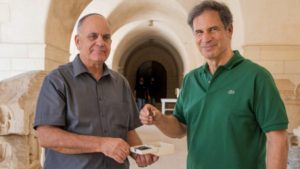By Naama Barak

(Israel21c via JNS) When Eytan Stibbe heads off to the International Space Station at the end of the year, becoming only the second Israeli ever to go into space, he’ll take with him a 1,900-year-old coin recently unearthed in the Judean Desert.
Stibbe recently visited the Israel Antiquities Authority’s Dead Sea Scrolls laboratory in Jerusalem, where he was shown ancient scroll fragments from the Book of Enoch discovered together with other biblical texts in the Judean Desert caves.
At the end of his visit, IAA Director Eli Eskosido presented Stibbe with a coin dating to the second Jewish revolt against the Romans, known as the Bar Kokhba Revolt, and bearing the name of its leader, Shimon Bar Kochba.
Both sides of the coin bear Jewish symbols typical of the Second Temple period: a palm tree with the inscription “Shimon,” of which only two letters are discernable, and a vine leaf with the inscription “Year Two of the liberty of Israel.”
The coin was recently discovered in a cave in the Judean Desert known as the Cave of Horror, alongside other coins used by rebels, fragments of ancient biblical scrolls, a 6,000-year-old skeleton of a young child and the oldest woven basket known to mankind.
“As part of the ‘Rakia’ mission to the International Space Station, I will be taking with me a bag filled with items that have a special meaning to me. It was clear to me that one of these items will be a symbol of Jewish history,” said Stibbe.
“I saw the coin, minted with the palm tree and vine leaf, that for me represent the connection to the land, the love of the country, and the desire of the population of Israel in those years for independence,” he added.
This article was first published by Israel21c.